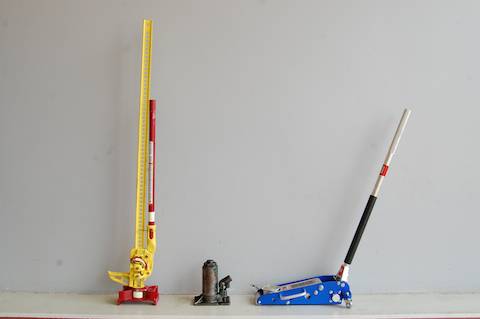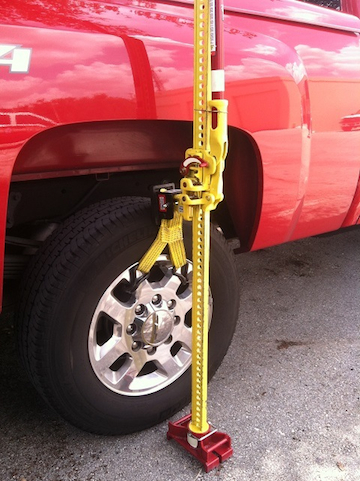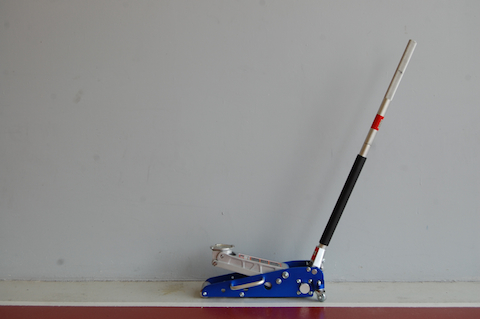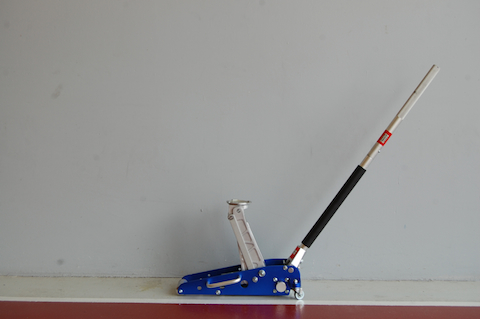There are three main styles of jacks that a frequently found on our rigs. They each have their strengths and weaknesses, so we decided to do a little comparison in this post. The three main jacks that will be discussed are Hi-Lift Jacks (left), Bottle Jacks (middle), and Racing Style Floor Jacks (right).

Bottle Jacks are the smallest (in size) of the jacks reviewed. The size to lift ratio on this style of jack is tremendous with some bottle jacks having lift capacities in excess of 20 tons. Most bottle jacks have an adjustment screw that can be used to bridge the gap from the jack’s fully collapsed (stored) size to the height of load that will be lifted. The adjustment screw prevents wasting any of the lifting stroke of the jack. The handle of a bottle jack is typically small, and requires more movements to produce lift. The handle size and location typically require the operator to be very close, and possibly under the load, which present obvious safety concerns.
A small 2 ton bottle jack would have a 7†stored height with about 5†of potential lift. This would result in about 12†of extended height up to about 15†of height when the extension screw is in use. This jack would typically have a 3.5’ x 4†base and weigh about 6 pounds. Keep in mind that the 7†stored height of this jack won’t fit under most common passenger vehicles.
A larger 20 ton bottle jack would have a 11†stored height with about 7†of potential lift. This would result in about 18†of extended height up to about 21†of height when the extension screw is in use. This jack would typically have a 6†x 6.5†base and weigh about 31 pounds.
Racing jacks (floor jacks) are the quickest an easiest to use of the different jacks being discussed. Racing jacks are typically fabricated out of steel, aluminum, or a combination. Aluminum is obviously the lightest, and as a result, is typically the most expensive. Aluminum is the best choice for our use since we’ll be required to pull the jack out of a compartment. No reason to create a career ending injury just to save a little bit of cash on this useful piece of equipment. Racing jacks with the single solid large wheel on the front are better and easier to maneuver than the ones with two smaller wheels on either side of the jack. Some manufactures even offer a “low profile†racing jack if the average stored height is a concern. Racing jacks typically have long handles that place the operator away from the lift. This provides a little more safety and allows the operator to see more of the lifting evolution during its use. Racing jacks also require the fewer movements of the handle to produce all of the jacks lift potential. The one pictured here produces 1 ¼†of lift with each pump and only requires 9 pumps. One drawback to the racing jack is the natural arc of movement produced during the lift. As long as this arc is understood and anticipated ahead of time, it shouldn’t produce too much of an issue during a typical lifting operation. Because of this arc either the jack, or the load is going to move during the lift. There might be certain operations where this arc could cause issue however. Racing jacks also have the ability to roll with a load on them, which again, depending on circumstances could be either a good thing or bad thing.
Both the bottle jack and racing jack produce their lift via a hydraulic cylinder. As with any other hydraulic cylinder, they need to periodically be used and placed under a load. Simply taking the jack out of the compartment and operating it in a non-loaded fashion is not enough. Placing it under a load ensures that the O-rings maintain lubrication, and handle pressure, and support a load. Any time a new jack is placed in service it should be noted how many pumps it requires to operate correctly. Its not a bad idea to write on the jack how many pumps it takes so you can always gauge the jack’s performance.
Hi-Lift jacks come three different lengths, and even a specialized series of “first responder†jacks. All three models are rated at 4660lbs (but are tested to 7000lbs. Its important to note that the last 12†of lifting height of the larger 60†jack is only rated for 2660lbs (tested to 4000lbs.) Please note that the Hi-Lift shown in these photos has the top clamp-clevis removed due to the way the jack is stored in the rig.
The 36†Hi-Lift weighs 27lbs max and has a max lifting height of 27â€. The 48†Hi-Lift weighs 30.2lbs and has a max lifting height of 38.63â€. The 60†Hi-Lift weighs 33.3lbs and has a max lifting height of 49.75â€.
The Hi-Lift has the greatest range of motion, each pump of the handle produces about 7/8†of lift requiring 55 pumps to produce 50†on lift on the largest jack. The jack tends to be unstable when standing on it’s own, but it becomes much more stable when placed under a load. The part that actually holds the load is relatively small, and does not project far from the jack, this limits the lift (or purchase) points of the jack. Most modern vehicles don’t have solid bumpers anymore, so we have to look for other options. One of the most effective lift points on a vehicle is the wheel well. It will damage the vehicle, but if someone is trapped under it, that should be the least of your worries. Hi-Lift also offers an accessory called the LM-100 Lift Mate, which is specifically made for this purpose and to prevent damage. The Lift Mate is rated at 5,000lbs and attaches to the jack to provide two hooks that can attach to almost any style wheel. This allows the jack to get a purchase on the wheel as the lift point as shown below.

The Hi-lift requires the most maintenance of each of the jacks reviewed. The climbing pins and reversing latch all need to be lubed in order to work smoothly. The Hi-Lift also requires the most training to remember how to use it correctly. However, the most interesting thing about Hi-Lift’s is that they can be used for much more then simple lifting operations. For example, they can be used either as a winch or as a clamp with a 7000lb rating. These expanded capabilities make the Hi-Lift (particularly the first responder edition) and excellent “tool for the tool box.â€
Click here for the detailed instruction manual on the jack.
In the photo below each jack is raised to it’s highest point.

As with any other lifting operation, the adage of lift-an-inch / crib-an-inch applies. We should not make a habit of operating under a load that is only supported by a jack, regardless of which type of jack it is. A quick stack of cribbing makes the operation much safer with little effort. Anytime we are lifting a vehicle we should make sure to chock the wheels to prevent any front to back movement during the lifting operation. We need to remember that when we raise a vehicle on the front and back axis, the vehicle will naturally raise in an arc motion. Both the bottle jack, and the Hi-Lift jacks remain stationary, which could result in either the jack tipping over, or the vehicle slipping off the lift point of the jack. The floor jack on the other hand is designed to work with this arc, since it can roll into position.
The two photos below show how arc that is created as the racing jack is operated.


As we mentioned earlier each jack has its pros and cons, its all a matter of determining what your needs are and understanding which jack is best for the task at hand. Its not a bad idea to have one (or more) of each style jack available for whatever may come your way.

Not all fire apparatus need a pump and water, but I firmly believe all fire apparatus should have a hi-lift jack. The First Responder model is more expensive, but the basic model can be had for well under $100 and provides a host of capabilities. Training from a knowledgeable person is necessary, and, as my grandfather told me, “don’t get in front of the moving parts, boy”, and you’ll be fine.
Think your good at extrication. Try using a Hi-lift, a Sawzall and some 3/8″ chains. You can get a lot done!!!
The Hi-lift with the large base works great.
Racing Floor Jacks… Love em’
By far the quickest, least manpower intensive, and for that matter one of the safest ways to remove pedestrians pinned beneath a vehicle. (Using cribbing of course to capture each inch you lift)
It’s such a fast set-up that in the event of a crush injury being present, your ready to safely lift but often waiting for ALS interventions to be in place unless it’s a code or breathing is compromised.
Other uses include:
Post extrication cribbing removal
Assisting motorists with a tire change
And putting the rookie’s personal vehicle up on blocks
I agree with Phil and Steve, if a department can’t afford to run a basic set of hydrailic extrication tools or strut shoring on most on it’s rigs that run vehicle crashes, WITH LOTS OF PRACTICE you can do alot with Hi Lift Jack(s, chains, and a reciprocating saw with the correct blades.
In the article it mentions hooking the fender to lift a car with the high-lift. It works well to loop a chain or strap through opposing holes or slots in a wheel, and us that strap or chain as your lift point, limiting further body damage.
Posted too soon/got to add. High-Lift makes an accessory strap, the LM-100 Lift-Mate for lifting by the wheel.
@Peter, we didn’t have pictures of the Lift Mate when we first created the post, but we went back and added them. Thanks for the input! -Jimm-
hi, I would like to buy hi lift jacks how much does it cost me and where I can buy it in Australia Melbourne.
thank you
http://www.hi-lift.com/
http://www.amazon.com/s?ie=UTF8&page=1&rh=i%3Aaps%2Ck%3Ahi%20lift%20jack
to the post from Feb 16th. Here are two sites you can check to purchase. Basic set 40-80$ US dollars and lots of accesorries to choose from.